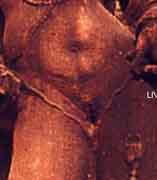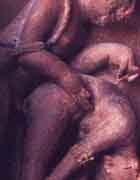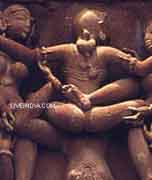History
Khajuraho
invokes the mind, Fires the imagination. Hundreds of miles from civilization,
deep
in
the hinterlands of central India where the tiger still has its own domain
and where the depths of the forests hold their own secrets are a small
clearing. Here: a village, modest by any standards; a tank, ambitiously
called a lake; groups of ancient temples, some in ruins. For most people,
Khajuraho continues to remain an enigma, a quest in the arena of world
art.
What
is the significance of its temples? What pattern did they fit into in the
ancient past, and why were
temples
used as an art gallery? If there existed a kingdom here, where are the
remains of grand mansions and grander palaces? Why is it that only temples
have been discovered? Were these temples religious in nature?
If
so, how does one justify the presence of some of the most graphic representations
of sexual scenes
the
world has ever known? Art historians have tried for years to seek a solution
to the mystery of Khajuraho, but all attempts to do so must eventually
be reduced to conjecture, for there are no records to reveal the purpose
for the building of these temples. Perhaps we will never know; that is
certain. However, Khajuraho will continue to draw homage from travellers
and art lovers, as it has done ever since its revival.
An
Ancient Past
Ancient
dynasties are often covered in a veil of mystery, largely because written
records are rare and,
as
is often the case in India, myth and legend weave their way over time into
the history of their origin and their reign. And when the dynasty leaves
a legacy as contradictory as the Khajuraho temples, with their mix of the
religious and the sensuous, the web is woven of brighter threads, the accompanying
legends more colourful. Khajuraho or 'Khajur-vahika' (bearer of date palms),
also known as 'Khajjurpura' in ancient times, evidently derives its name
from the golden date palms (khajur) that adorned its city gates and, if
the different legendary versions are to be believed, it owes its existence
to an enchanting maiden named Hemvati.
According
to the account of the medieval court poet, Chandbardai, in the Mahoba-khand
of his Prithviraj
Raso,
Hemvati was the beautiful daughter of Hemraj, the royal priest of Kashi
(Varanasi). One summer
night,
while she was bathing in the sparkling waters of a lotus-filled pond, the
Moon god was so awestruck by her beauty that he descended to earth in human
form and ravished her. The distressed Hemvati, who was unfortunately a
child widow, threatened to curse the god for ruining her life and reputation.
To make amends for his folly the Moon god promised that she would become
the mother of a valiant son. 'Take him to Khajjurpura', he is believed
to have said. 'He will be a great king and build numerous temples surrounded
by lakes and gardens. He will also perform a yagya (religious ceremony)
through which your sin will be washed away.' Following his instructions,
Hemvati left her home to give birth to her son in a tiny village. |
|














